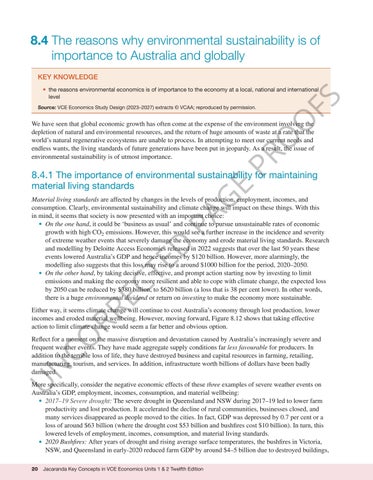“c08EconomicsAndTheEnvironment_PrintPDF” — 2022/6/6 — 17:03 — page 20 — #20
8.4 The reasons why environmental sustainability is of importance to Australia and globally KEY KNOWLEDGE
FS
• the reasons environmental economics is of importance to the economy at a local, national and international level
O
Source: VCE Economics Study Design (2023–2027) extracts © VCAA; reproduced by permission.
PR
O
We have seen that global economic growth has often come at the expense of the environment involving the depletion of natural and environmental resources, and the return of huge amounts of waste at a rate that the world’s natural regenerative ecosystems are unable to process. In attempting to meet our current needs and endless wants, the living standards of future generations have been put in jeopardy. As a result, the issue of environmental sustainability is of utmost importance.
G
E
8.4.1 The importance of environmental sustainability for maintaining material living standards
CO RR EC
TE
D
PA
Material living standards are affected by changes in the levels of production, employment, incomes, and consumption. Clearly, environmental sustainability and climate change will impact on these things. With this in mind, it seems that society is now presented with an important choice: • On the one hand, it could be ‘business as usual’ and continue to pursue unsustainable rates of economic growth with high CO2 emissions. However, this would see a further increase in the incidence and severity of extreme weather events that severely damage the economy and erode material living standards. Research and modelling by Deloitte Access Economics released in 2022 suggests that over the last 50 years these events lowered Australia’s GDP and hence incomes by $120 billion. However, more alarmingly, the modelling also suggests that this loss may rise to a around $1000 billion for the period, 2020–2050. • On the other hand, by taking decisive, effective, and prompt action starting now by investing to limit emissions and making the economy more resilient and able to cope with climate change, the expected loss by 2050 can be reduced by $380 billion, to $620 billion (a loss that is 38 per cent lower). In other words, there is a huge environmental dividend or return on investing to make the economy more sustainable. Either way, it seems climate change will continue to cost Australia’s economy through lost production, lower incomes and eroded material wellbeing. However, moving forward, Figure 8.12 shows that taking effective action to limit climate change would seem a far better and obvious option.
U
N
Reflect for a moment on the massive disruption and devastation caused by Australia’s increasingly severe and frequent weather events. They have made aggregate supply conditions far less favourable for producers. In addition to the terrible loss of life, they have destroyed business and capital resources in farming, retailing, manufacturing, tourism, and services. In addition, infrastructure worth billions of dollars have been badly damaged.
More specifically, consider the negative economic effects of these three examples of severe weather events on Australia’s GDP, employment, incomes, consumption, and material wellbeing: • 2017–19 Severe drought: The severe drought in Queensland and NSW during 2017–19 led to lower farm productivity and lost production. It accelerated the decline of rural communities, businesses closed, and many services disappeared as people moved to the cities. In fact, GDP was depressed by 0.7 per cent or a loss of around $63 billion (where the drought cost $53 billion and bushfires cost $10 billion). In turn, this lowered levels of employment, incomes, consumption, and material living standards. • 2020 Bushfires: After years of drought and rising average surface temperatures, the bushfires in Victoria, NSW, and Queensland in early-2020 reduced farm GDP by around $4–5 billion due to destroyed buildings, 20
Jacaranda Key Concepts in VCE Economics Units 1 & 2 Twelfth Edition





















































